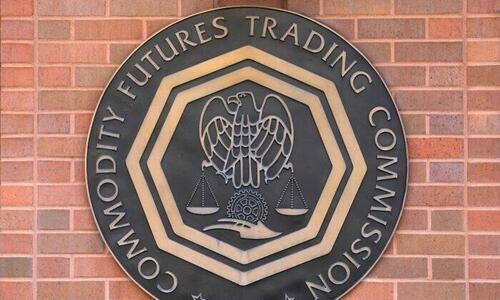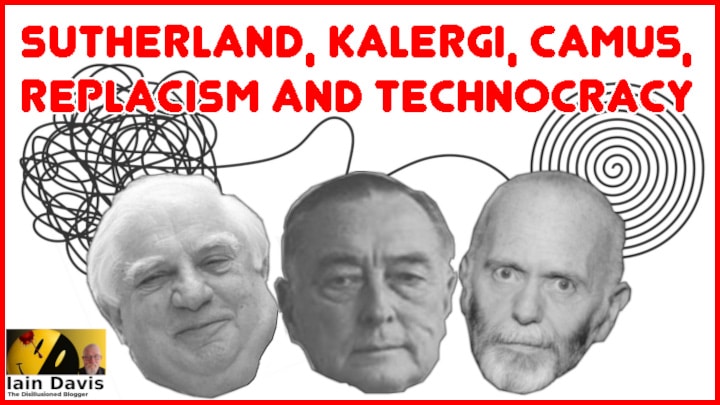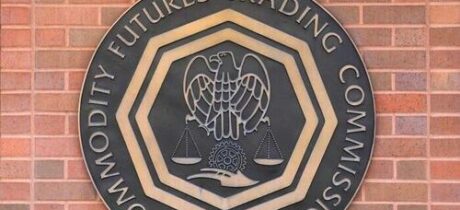
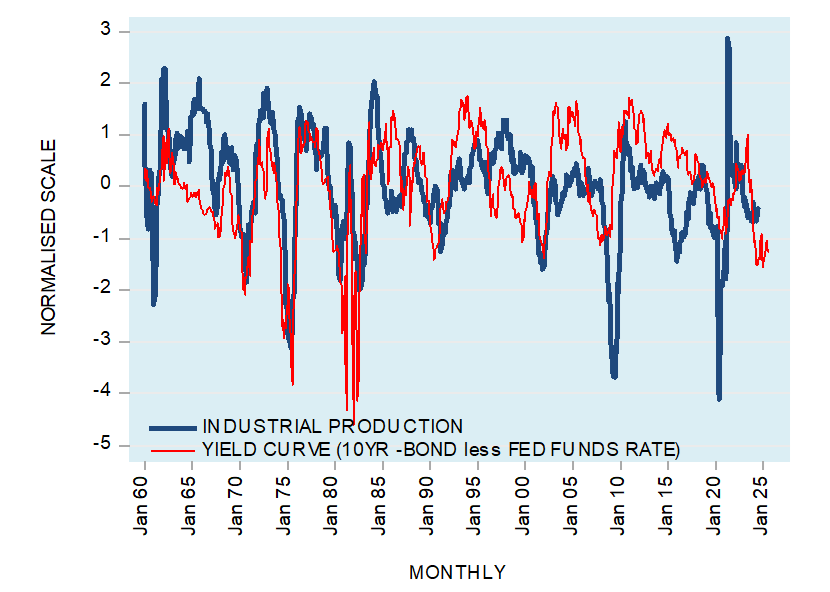
The Fed is warping the shape of the yield curve
Many commentators consider the spread between the long-term interest rate and the short-term interest rate as an important indicator to establish the future course of economic activity. An increase in the spread is seen as pointing toward good economic times ahead. Conversely, a declining spread raises the likelihood of an economic recession.
Historically, in the U.S., the differential between the yield on the 10-year T-bill and the federal funds rate was leading the yearly growth rate of industrial production by 12 months (see Figure 1).
Figure 1: Year-over-year U.S. industrial production versus 12-month yield curve lag (%)
Source: Federal Reserve Bank of St. Louis (FRED)
A popular explanation for the determination of the shape of the yield spread is provided by expectations theory. According to this theory, the key to the shape of the spread — also known as the yield curve — is that the long-term interest rates are the average of the present and the expected short-term interest rates.
Thus, if today’s one-year rate is 4% and the next year’s one-year rate is expected to be 5%, then the two-year rate today should be 4.5%, or (4 + 5) / 2 = 4.5. Here, the long-term interest rate (i.e., the two-year rate today) is higher than the present short-term interest rate (i.e., the one-year rate).
It follows then that expectations for increases in the short-term interest rate will make the yield curve upward sloping, as the long-term interest rate is higher than the short-term interest rate. Conversely, expectations for a decline in the short-term interest rate is going to result in a downward-sloping yield curve, as the long-term interest rate is lower than the short-term interest rate.
If today’s one-year interest rate is 4% and the next year’s one-year interest rate is expected to be 3%, then the two-year interest rate today should be 3.5%, or (4 + 3) / 2 = 3.5. The long-term interest rate (i.e., the two-year interest rate today) is lower than the present short-term interest rate.
According to expectations theory, whenever investors expect economic expansion, they anticipate rising short-term interest rates. Consequently, the long-term interest rate is going to be higher than the short-term interest rate — hence, an upward-sloping yield curve emerges.
Conversely, an economic slump is associated with the expectations for a declining short-term interest rate. As a result, according to expectations theory, the long-term interest rate today will be lower than the short-term interest rate — a downward-sloping yield curve emerges.
A good correlation between the yield curve and economic activity does not explain, however, why the yield curve is a good predictor of economic activity. The correlation only describes it.
Shape of the yield curve in an unhampered market
Ludwig von Mises concluded that in a free, unhampered market economy, the natural tendency of the shape of the yield curve is neither toward an upward-sloping curve nor toward a downward-sloping curve but rather toward a flattening one.
Mises wrote:
“The activities of the entrepreneurs tend toward the establishment of a uniform rate of originary interest in the whole market economy. If there turns up in one sector of the market a margin between the prices of present goods and those of future goods which deviates from the margin prevailing on other sectors, a trend toward equalization is brought about by the striving of businessmen to enter those sectors in which this margin is higher and to avoid those in which it is lower. The final rate of originary interest is the same in all parts of the market of the evenly rotating economy.”
Also, Murray Rothbard held that in a free, unhampered market economy, an upward-sloping yield curve cannot be sustained because it would set in place an arbitrage between short- and long-term securities.
This would lift the short-term interest rates and lower the long-term interest rates, resulting in the tendency toward a uniform interest rate. Arbitrage will also prevent the sustainability of a downward-sloping yield curve by shifting funds from long maturities to short maturities — thereby flattening the curve. Hence, in a free, unhampered market economy, an upward- or a downward-sloping yield curve cannot be sustained.
What is the mechanism that generates a sustained upward- or downward-sloping yield curve? The shape of the yield curve is the outcome of the Federal Reserve’s monetary policies.
How the Fed’s tampering generates an upward- or a downward-sloping yield curve
While the Fed can exercise control over the short-term interest rates via the federal funds interest rate, it has less control over the longer-term interest rates. In this sense, the long-term interest rates can be seen as partially reflecting the time preferences of individuals.
The Fed’s interest rate policy disrupts the natural tendency toward the uniformity of interest rates. This leads to the deviation of the short-term interest rates from individuals’ time preferences as partially mirrored by the relatively less-manipulated long-term interest rate.
When the Fed lowers the policy interest rate target, this almost instantly lowers the short-term interest rates, while to a lesser extent affecting the longer-term interest rates. As a result, an upward-sloping yield curve develops. (The interest rate differential between the long-term interest rate and the short-term interest rate widens.)
Conversely, when the Fed reverses its stance and lifts the policy interest rate target, this lifts the short-term interest rates. As a result, a downward-sloping yield curve emerges. (The differential between the long-term interest rate and the short-term interest rate narrows.)
The deviation of short-term interest rates from long-term rates due to the Fed’s tampering falsifies the signals issued by consumers to producers. This, in turn, culminates in the misallocation of resources and leads to economic impoverishment. Consequently, producers generate products that are not in line with the consumers’ instructions.
For example, when the Fed lowers its policy interest rate to encourage an expansion in the production structure, it does so in contrast to consumers’ time preferences. Consumers have not allocated an adequate amount of real savings. Hence, producers do not have enough real savings to undertake the expansion of the infrastructure, which leads to an economic bust.
The Fed’s interest rate framework is not based upon individuals’ time preferences but rather on political factors. By using the expectations-theory framework, the Fed sets long-term interest rates. Hence, according to expectations theory, the Fed is a major factor in setting the shape of the yield curve. The Mises-Rothbard framework also assumes the Fed influences the shape of the yield curve. However, the Fed does this by disrupting the natural tendency of the curve to gravitate toward being horizontal.
Why do changes in the shape of the yield curve precede economic activity?
Whenever the central bank reverses the interest rate stance, altering the shape of the yield curve, it leads to either an economic boom or an economic bust, although they do not arise immediately. The reason is that the effect of a change in the interest rate policy shifts from one market to another market.
For example, during an economic slump, the central bank reduces the policy interest rate. Consequently, a steepening of the yield curve emerges. This, however, has a minimal effect on economic activity, which is still dominated by the previous tight interest rate stance. It is only later, once the easy stance begins to dominate the economy that economic activity starts improving. If the pool of real savings is declining, then — notwithstanding the increase in the yield curve — economic activity is likely to remain under pressure. Hence, the historical correlation between the yield curve and economic activity is going to provide misleading reading.
Conclusion
Historically, in the U.S., there has been a good visual correlation between the yield curve and economic activity. However, correlation can only describe but not explain. The economic bust is likely to emerge notwithstanding an upward-sloping yield curve if the pool of real savings is declining or exhausted. Expectations theory, which is based on historical good visual correlation between the yield curve and economic activity, cannot provide a trustworthy explanation regarding the boom-bust cycles.
Originally Posted at https://mises.org/
Stay Updated with news.freeptomaineradio.com’s Daily Newsletter
Stay informed! Subscribe to our daily newsletter to receive updates on our latest blog posts directly in your inbox. Don’t let important information get buried by big tech.
Current subscribers:
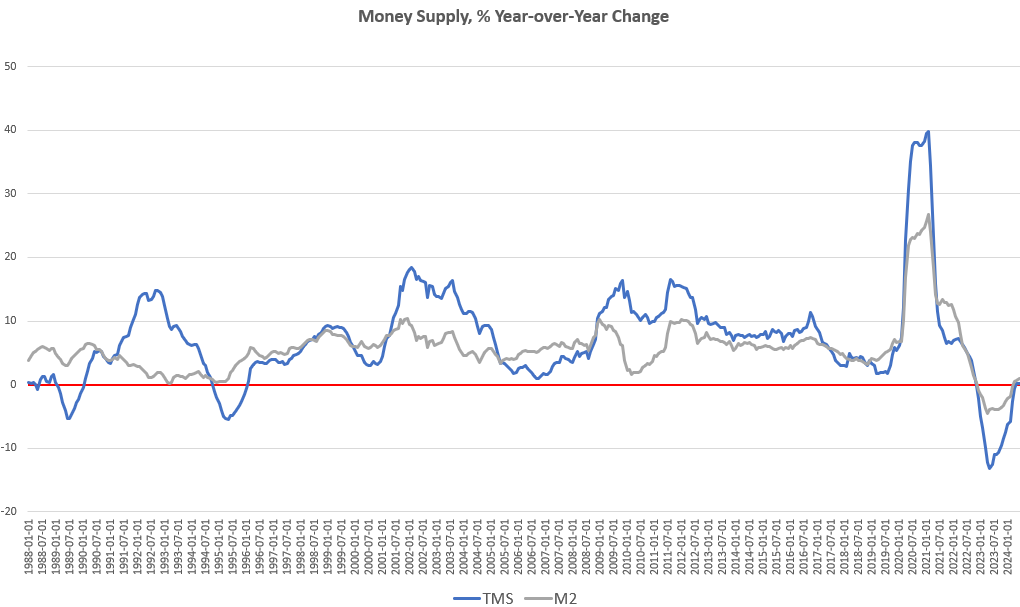
Money-Supply Growth Accelerates as Wall Street Demands Even More Easy Money
Money-supply growth rose year over year in June for the second month in a row. This is the first time the money supply has grown for two months in a row since October of 2022. The current trend in money-supply growth suggests a significant turnaround from more than a year of historically large contractions in the money supply that occurred throughout much of 2023 and 2024. As of June, the money supply appears to be, for now, in a period of stabilization.
The money-supply growth of May and June ends an eighteen-month period during which the money supply repeatedly contracted, year over year. In June, YOY growth in the money supply was at 0.24 percent. That’s the same as the May 2024 increase, and was a large reversal from June 2023’s YOY decline of 12.5 percent. Until recently, the US money supply was experiencing a period of the the largest drops in money supply we’ve seen since the Great Depression. Prior to 2023, at no other point for at least sixty years had the money supply fallen by so much.
Those dramatic drops in the money supply appear to be over for the time being. Indeed, when we look at month-to-month changes in the money supply, we find that the money supply was flat from May to June, increasing by 0.002 percent. In month-to-month measures, money supply growth has been positive during seven of the last twelve months, further suggesting that the new trend in money supply is either flat or returning to sustained upward growth..

The money supply metric used here—the “true,” or Rothbard-Salerno, money supply measure (TMS)—is the metric developed by Murray Rothbard and Joseph Salerno, and is designed to provide a better measure of money supply fluctuations than M2. (The Mises Institute now offers regular updates on this metric and its growth.)
In recent months, M2 growth rates have followed a similar course to TMS growth rates, although TMS has fallen faster than M2 in the year-over-year measures, and M2 has rebounded faster. In June, the M2 growth rate was 0.983 percent. That’s up from May’s growth rate of 0.58 percent. June’s growth rate was also up from June 2023’s rate of -3.8 percent. Moreover, M2 also shows more overall growth than TMS, with M2 increasing by 0.55 percent from May to June this year.
Money supply growth can often be a helpful measure of economic activity and an indicator of coming recessions. During periods of economic boom, money supply tends to grow quickly as commercial banks make more loans. On the other hand, two or three years before a recession begins, we tend to see periods during which money supply growth slows or turns negative.
It should be noted that the money supply does not need to actually contract to signal a recession. As shown by Ludwig von Mises, recessions are often preceded by a mere slowing in money supply growth. But the drop into negative territory we’ve seen in recent months does help illustrate just how far and how rapidly money supply growth has fallen. That is generally a red flag for economic growth and employment.
All that said, recessions tend not to become apparent until after the money supply has begun to accelerate again after a period of slowing. This was the case in the early 1990’s recession, the Dot-com Bust of 2001, and the Great Recession.
In spite of last year’s sizable drops in total money supply, the trend in money-supply remains well above what existed during the twenty-year period from 1989 to 2009. To return to this trend, the money supply would have to drop another $3 trillion or so—or 15 percent—down to a total below $15 trillion. Moreover, as of June, total money supply was still up more than 30 percent (or about $4.6 trillion) since January 2020.

Since 2009, the TMS money supply is now up by more than 185 percent. (M2 has grown by 145 percent in that period.) Out of the current money supply of $18.8 trillion, $4.6 trillion—or 24 percent—of that has been created since January 2020. Since 2009, more than $12 trillion of the current money supply has been created. In other words, nearly two-thirds of the total existing money supply have been created just in the past thirteen years.
With these kinds of totals, a ten-percent drop in the money supply only puts a small dent in the huge edifice of newly created money. The US economy still faces a very large monetary overhang from the past several years, and this is partly why so many months of negative money-supply growth, total employment has only stagnated while showing no large contractions. (For example, full-time job growth has turned negative while the total number of employed workers has been flat since late 2023.) Moreover, CPI inflation remains well over the two-percent target rate, and mainstream economists’ predictions of significant “disinflation” have been wrong.
Wall Street Wants More Money-Supply Growth
As economic indicators continue to weaken, we should expect to hear an increasing chorus of demands for inflationary monetary policy designed to accelerate money supply growth.
For example, last week’s weak jobs report led to numerous calls from Wall Street pundits for more dovish policy from the Federal Reserve. On Monday, economist and longtime Wall Street “expert” Jeremy Siegel seemed nearly hysterical as he demanded the Fed hold an emergency meeting and slash the target policy interest rate by 150 basis points over the next two months. This can only be described as “panic.” This followed a cloud of other establishment economists who declared on Friday that the Fed should have begun cutting rates many months ago.
Remote video URL
Even a small downward drift in the markets demands an aggressive policy response in the minds of Wall Street boosters. In other words, the Greenspan put remains as essential as ever in the minds of Wall Street’s “elites.” Now, of course, the Greenspan put has been replaced by the Bernanke put, the Yellen put and the Powell put. Even with the total money supply well above trend and still bumping around 19 trillion, people like Jeremy Siegel would have you believe the Fed has been aggressively hawkish. For the nation’s banker class, it is always the right time to push more easy money in order to keep asset prices as levels that keeps “the 1%” awash in riches.
The Fed and the Federal Government Need Lower Interest Rates
Part of the reason that banker class never tires of easy money, however, is that the wealthiest have many ways of dealing with mounting consumer price inflation. So long as prices in real estate, stocks, and other asset classes continue to inflate faster than prices for food and other basics, then inflation presents no real problem for the wealthiest among us.
For those who don’t own immense stockpiles of assets, however, consumer price inflation can be devastating.
Thus, the only real restraint on easy money is the fact public opinion will turn against the regime when easy-money fueled price inflation accelerate for ordinary people. Regimes fear high levels of price inflation because high inflation is known to lead to political instability.
One way that central banks fight price inflation is to allow interest rates to rise, but this means public dissatisfaction with rising prices must compete with incessant calls for lower interest rates coming out of Wall Street—as we see above—and also out of the regime itself.
Central banks are not expected only to keep Wall Street happy. A regime’s central bank is also expected to help the regime issue debt and engage in deficit spending. Central banks’ main tool in offering this help involves keeping interest rates on government debt low. How do central banks do this? By buying up the government’s debt, thus artificially boosting demand for the government’s debt and pushing interest rates back down. The problem is that buying up government debt usually involves creating new money, thus putting upward pressure on price inflation.
Given all these pressures from the easy-money interests, it’s rather surprising that money-supply growth did not turn positive sooner than it did and that the central bank has not been more aggressive in pushing growth rates up faster.
What the Fed is doing now is probably best described as a “wait and hope” strategy. The Fed is refusing to allow interest rates to rise, but the Fed is still proceeding slowly on forcing interest rates down even further.
While the Fed is certainly responsive to Wall Street historically, the Fed’s larger concern right now is likely the need to push down interest rates on government debt. It appears the Fed is holding the target rate steady just hoping that something will happen to bring Treasury yields back down without the Fed having to print more money to buy more Treasuries and risking a new, politically damaging surge in price inflation. “Hoping” is not much of a strategy, however, and the likely outcome is that the Fed will err on the side of keeping interest rates low so the regime can borrow more money. This will mean more price inflation for ordinary people.
Originally Posted at https://mises.org/
Stay Updated with news.freeptomaineradio.com’s Daily Newsletter
Stay informed! Subscribe to our daily newsletter to receive updates on our latest blog posts directly in your inbox. Don’t let important information get buried by big tech.
Current subscribers:
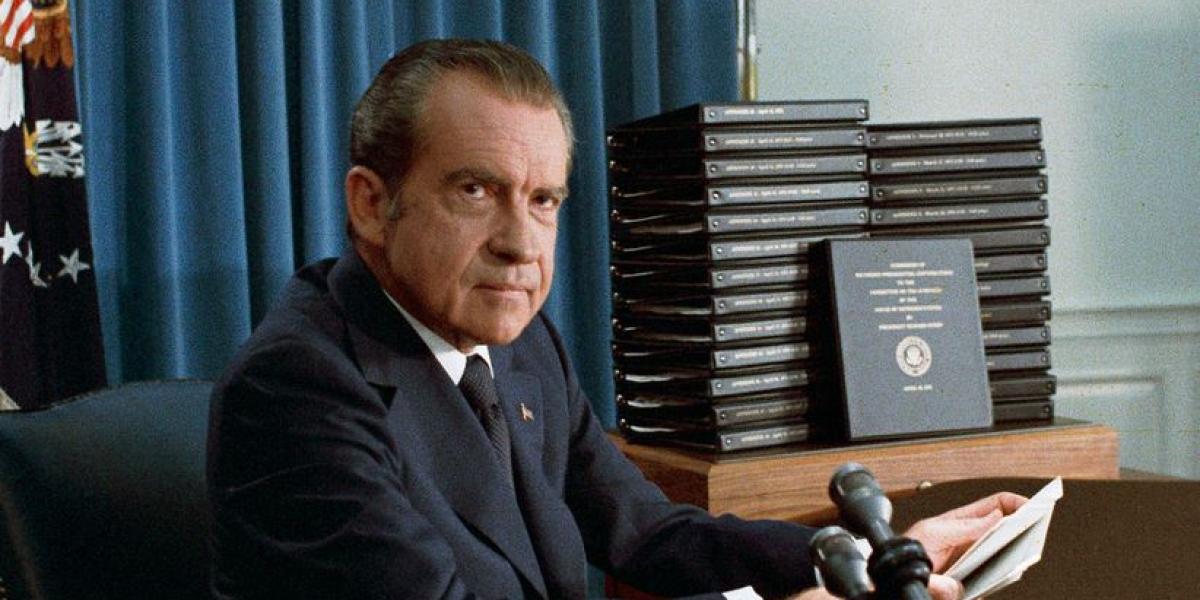
Yankees vs. Cowboys: Rothbardian elite theory on Watergate
Editors note: The following article was published in July 1974 in The Libertarian Forum titled “One Heartbeat Away.” In it, Murray Rothbard provides elite theory analysis of Watergate after the selection of Nelson Rockefeller as Gerald Ford’s Vice President. While Rothbard’s fear of a Rockefeller presidency did not come to fruition, his post-political life included the creation of the Trilateral Commission which continued to have incredible influence over future presidential administrations.
For more Rothbardian elite analysis similar to what is provided below, readers are encouraged to read Origins of the Federal Reserve and Wall Street, Banks, and Foreign Policy, the latter of which continues this analysis into 1984.
****
As the Watergate revelations poured out in the last years, our esteemed publisher, Joe Peden, began to say, in some awe, “all the most flagrant ‘paranoia’ of the New Left turns out to be correct analysis’” Of course, he could have substituted or added the Birchers for the New Left. “Paranoia” lives! and after the Pentagon Papers and the Watergate revelations the fashionable sneering at the “conspiracy theory of history” will never sit quite so smugly again. The “conspiracy theory of history” – which is really only praxeology applied to human history, in assuming that men have motives on which they act – has never looked so good or so rational.
Being away in Europe at the time of the amazing, cataclysmic appointment of Nelson Rockefeller to the Vice Presidency, I did not have a chance to observe the reactions of American opinion. But as far as I know, no one has pointed to the most important aspect of the appointment: that it provides a remarkable empirical confirmation of the leading “conspiracy thesis” about the Watergate Affair: the Oglesby-Sale, “Cowboy vs. Yankee” hypothesis. The appointment of the man who embodies the Big Business Corporate State, the living representative of the corporate statism that has grown like a cancer since the Progressive Period In America (after about 1900), to be the heir apparent, and a heartbeat away from the most powerful post in the world, is enough to give any American, let alone any libertarian, the heebie-jeebies. The accession of Nelson Rockefeller to total power would mean the final fusion of the most colossal aggregation of political and economic power that the world has ever seen. And the only groups that have warned us of this coming event have been the major groups totally outside the American Dower structure: the extreme left and the “extreme”. or Birchite, right, who in their different yet complementary ways have been writing unheeded about the menace of the “Rockefeller World Empire” and its drive for total dominion.
*****
When Nelson Rockefeller first appeared on the electoral scene in his successful race for the New York governorship in 1958, Frank S. Meyer, the valiant leader of the quasi-libertarian wing of the National Review clique, denounced Rockefeller as “Caesar Augustus”, the destroyer of the American Republic. The feeble and perfunctory opposition that NR has put up to Rockefeller now (combined with its kept Conservative Party’s endorsement of Rocky’s stooge Malcolm Wilson) only indicates how far National Review has gone in its urge to join the ruling Establishment. In addition to Meyer, there emerged also an eccentric (to use a charitable term) eye doctor in New York named Dr Emanuel M. Josephson, a conspiracy theorist to end all conspiracy theories, a “paranoid” among the paranoids. But while the good doctor’s historiographical methodology left a great deal to be desired (e.g. his idea that the Rockefellers run world Communism, plus many other aberrations), he was and probably still is the world’s outstanding “Rockefeller-batter”, an enthusiastic collector of any and all facts about the Rockefeller family At any rate, Josephson sprang into action, declaring that the Rockefellers felt so secure of their political control of the country that they were now ready to reach for open (in contrast to their previously hidden) political power, in the shape of Nelson as President. Not only that six years earlier, in 1952, Dr Josephson had written, In his magnum opus, Rockefeller “Internationalist”: The Man Who Misrules the World, the following paragraph, which now seems remarkably prophetic:
“The pattern of his activities indicates that it is the objective of the Rockefellers to place Nelson Rockefeller in the White House by some means, whether direct, indirect or cataclysmic. Direct election as President is now possible with the sham ‘philanthropic’, ‘benevolent’ and ‘public spirited’ build up he has had; but it is improbable. More probable would be his nomination as Vice Presidential candidate on one of their ‘bipartisan’ or ‘omnipartisan’ tickets at the side of a Presidential candidate whom they know to be tottering at the edge of the grave, or who could be disposed of by some other of the methods of purging that have become so commonplace during the New and Fair Deals.” (p. 49)
Before proceeding to the Nelson appointment and its background, a brief but vitally important sketch is in order of what I believe to be a sound “conspiracy” analysis of the essence of twentieth century political and politico-economic history. By the late nineteenth century, the Democratic Party was largely in the control of the Morgan financial empire, and of its financial and industrial allies. Augustus Belmont, a Morgan ally, was the secretary of the national Democratic Party for decades, and an analysis of the Cleveland Administration’s (the only Democratic regimes from the Civil War to Woodrow Wison) shows Morgan partners and lawyers dominant in the key Cabinet positions. By the latter years of the century, on the other hand, the Republican Party became more loosely under the control of the Rockefellers, through Rockefeller domination of the Ohio Republican Party (old John D.’s original home and economic base was in Cleveland. Note that Ohio Republicans formed ‘every Republican-Administration since and including Benjamin Harrison (e.g. Willlam McKinley, WilIiam Howard Taft. and Warren G. Harding.) While both the Morgans and the Rockefellers used their political power for subsidies and contracts, and for imperial expansion- abroad, the roughly laissez-faire system meant that the evil effects on the country and the economy of these power plays were relatively limited. Then, around 1900, the Big Business interests, especially those grouped around Morgan, having failed dism_ally to achieve monopolies in each industry on the free market,_ decided to change the American system into a corporate. state, into a neo mercantilist Big Government which would cartelize the economy for their benefit. While Rockefeller did not fight this trend, the Morgans were far more assiduous in pushing the new system and the new theory.
The delicate political balance of power was broken with the assassination of Rockefeller’s man William McKinley, for, as a gesture to appease the Morgans, who had fought the McKinley nomination, the Republicans had chosen the young Morgan man, Theodore Roosevelt, for the seemingly harmless post of Vice President. (The Morgans were forced to shift, at least temporarily, to the Republicans because of the capture of the Democratic machinery by the leftist populist William Jennings Bryan). As soon as Teddy Roosevelt became President by the accident of (Yes, another!) “lone nut”, he began to wield the Sherman Antitrust Act, which had been a literal dead letter until then, as a political club. The club was used savagely’ to batter – guess who? – the Rockefellers, leading to the coerced dissolution of the Standard Oil combine by the federal government. It was at this point, Dr. Josephson speculates – probably correctly – that old John D. decided to beat his enemies at their own game, to become even more statist than they, to use every political and public relations weapon at his and his allies’ command. Roosevelt’s successor, William Howard Taft, an Ohio – and therefore Rockefeller – Republican, also wielded the antitrust weapon, to try to dissolve some other “bad” trusts. And what were these trusts? Again, you guessed it: key flagships in the Morgan empire: U. S. Steel, and International Harvester. The war of the titans was on, masked as high devotion to the antitrust ideal.
In retaliation for the Taft-Rockefeller policies, the Morgans and their numerous allies engineered the creation of the Progressive Party, which nominated Teddy Roosevelt for President for the successful purpose of destroying Taft. The Progressives, who not coincidentally had as their national chairman Morgan partner George W. Perkins, also served the ancillary goal of ideologically fostering the proto-New Deal system of the corporate state in America. The breaking of Taft swept into office Woodrow Wilson, who was also an ally of the Morgans, and who served to institute corporate state and Big Government policies in America, in both domestic institutions and in an interventionist and globalist foreign policy. By this time, the Morgans were losing ground in the competitive financial race to Kuhn-Loeb and the Jewish investment banking firms; but the·Morgans were able to recoup by pushing the Wilson Administration into war with Germany, a war necessary to the Morgans because the latter were the financial agents of the British and French governments, and had loaned heavily to Britain and France. Furthermore, the Morgans and their allies were heavily invested in the American export industries which received a great shot in the arm from Allied purchases and· government war contracts. Among big businessmen, only Rockefeller was hostile to the American entry into the war.
During the interwar years, with both financial groups converted to statism, the Morgans, still heavily invested.in Britain and France, began to drive toward American war with Germany:, which, with its bilateral economic agreements, remained stubbornly outside the Morgan financial ambit. On the other: hand, “the Rockefellers, with financial ties to L G. Farben in Germany were isolationists in Europe; with top Rockefeller ideologist (we’Il see why a bit later) John Foster Dulles – later the chief spokesman for pietistic global war writing a realistic book, War, Peace, and Change; calling for peaceful revision of the Versailles Treaty to meet legitimate German territorial demands in Europe. On the other hand, the Rockefeller’s, with heavy investments and financial ties with China, were pushing for war with Japan, while the European-centered Morgans were in favor of peaceful coexistence in Asia (thus, virtually the only high State Department official opposing war with Japan was Ambassador to Japan, Joseph C. Grew, a Morgan partner.)
World War II, which ended any sort of rieo-populist phase the New Deal may have had, and cemented the corporatist Big Business alliance with the Welfare-Warfare State, may be considered to be a deal between the Rockefellers and Morgans, with both getting a piece of the pie: the Morgans their war in Europe, and the Rockefellers their war in Asia.
Since World War II, American political history can no longer be analyzed in terms of a stark Morgan-Rockefeller conflict; instead, with of course shifting marginal influence, both groups have settled down into a happy joint “Eastern Establishment” rule over the United States, an “East” which more and more has included Chicago and the Old Middle West. In domestic affairs, this meant running an increasingly mighty Leviathan Corporate State; in foreign affairs, it meant global imperialism and the waging of counter-revolution and the Cold War throughout the globe. The final victory of this Eastern team was the literal stealing of the 1952 Republican nomination from Senator Taft (no longer a Rockefeller ally), by means of savage Wall St. banker pressure on the delegates who had been committed to the isolationist Taft.
One stark example of Rockefeller influence on American politics – particularly in the higher administrative positions – was the makeup of the Eisenhower Administration. The powerful Secretary of State and virtual maker of foreign policy was John Foster Dulles. Who was Dulles? A partner, in the first place, of the Rockefeller Wall St. law firm of Sullivan and Cromwell; but, in addition to that, and a little known fact, Dulles was married to Janet Pomeroy Avery, first cousin of John D. Rockefeller, Jr. Thomas E. Dewey’s political mentor was Rockefeller kinsman, Winthrop W. Aldrich, head of the extremely powerful Chase National Bank (its successor, Chase Manhattan, is now of course openly headed by David Rockefeller.) Head of the extraordinarily powerful and secret CIA was Dulles’ brother Allen, and their sister Eleanor was at the Asian desk of the State Department. To top it all off, Under Secretary of State was Christian Herter, whose wife was a member of the Pratt family, which has been intimately associated with the Rockefellers since old John D. got his start a century ago.
Even the New York Times cottoned to the egregious nature of Nelson’s claim that his personal stockholdings give him no major control over large corporations. First, we must realize that the Rockefeller Family votes and acts together through their family corporation; when we add Nelson’s, David’s, Laurence’s, and John’s holdings, plus their family trusts. plus the enormous stock held by the numerous Rockefeller Foundations. µlus their extremely powerful Chase Manhattan Bank, with its loans. holdings, and trust department, plus their long-time allied families (the Pratts, Flaglers, Whitneys, Bedfords, et al), plus their looser allies, plus the fact that working control of modern corporations does not need 51 % on the stock, we get an idea of the enormous Rockefeller power. From a free-market point of view, of course, there is nothing wrong with economic “power” per se; but when we realize the intimate connection between the Rockefellers and the corporate State of the U. S. government, our view changes. This is not free market money but intimate government-business partnership and control. (For the most recent scholarly study of current Rockefeller financial control, see James C. Knowles, “The Rockefeller Financial Group,” in R. Andreano, ed., Superconcentration Supercorporation (Andover, Mass.: Warner Modular Publications, 1973).
* * * *
This brings us to the great Nixon Caper. One of the glories of the market is that, even when greatly hobbled, competition and new wealth can break through. During the 1960’s, a loosely allied variety of new wealth and new industrial firms arose to challenge the dominance of the old Rockefeller-Morgan Eastern Establishment. The new -money was centered in such new industries as plastics, computers, and electronics, defense firms such as aircraft, in real estate, and in Texas oil (hide-bound Standard Oil, originally centered in Cleveland and western Pennsylvania oilfields, had been slow to realize the potential of the newly discovered Texas and· Oklahoma oil fields.) Geographically, the new wealth was centered in what Kirkpatrick Sale has called “the Southern Rim’’: Texas, Southern California, and Florida. Much of the new “wealth” was Texas-centered, and the political rise of Lyndon Johnson and John Connally was both fostered and encouraged by the economic rise of the new wealth.
Carl Oglesby’s happy term for the two new conflicting groups was the “Yankees” and the “Cowboys”. The fact of old vs. new wealth also engendered a difference in ideology, in attitudes, and lifestyles between the two groups. The Eastern Establishment Yankees, entrenched for generations, was and is aristocratic, smooth, cosmopolitan, well-educated, and highly sophisticated: able to mask their power and government loot behind a façade of intellectual apologetics, set forth by kept intellectuals, experts, and university professors. Being less hungry and more far-sighted, furthermore, the Yankees are typically willing to allow more dissent, civil liberties, and adherence to democratic forms, so long as their power remains essentially undamaged. The Southern Rim “Cowboys”, on the other hand, symbolized again by Johnson and Connally, take on the typical characteristics of the nouveau riche: hungrier, less sophisticated, more immediately grasping, and more willing to scuttle civil liberties in their thirst for power.
After Yankee Jack Kennedy was deposed by a “lone nut”, Cowboy Johnson was catapulted to power. What of the Nixon Administration? While Nixon himself was personally Cowboy (Southern California), his administration was clearly a Cowboy-Yankee coalition, with foreign policy wrapped up by the Rockefellers (Henry Kissinger was for years Nelson Rockefeller’s personal foreign policy adviser.) Economic policy was also basically Rockefeller, Arthur Burns having long been in the Dewey-Rockefeller ambit, and George Shultz being a member of the Pratt family (his middle name is Pratt). But the rest of the Administration was Cowboy, a designation that clearly applies to the West Coast and USC White House power boys, as well as Connally, and to Bebe Rebozo (Florida and Cuba: how Southern Rimmy can one get?)
The interesting focal question about the great media revelations on Watergate is: how come the powerful Establishment press (the New York Times, Washington Post, CBS, NBC) suddenly got honest? How come, that after years of supinely accepting federal government press handouts, they suddenly became demon investigative reporters in the great old, but forgotten, tradition? The point is not that the press was wrong and Nixon victimized about Watergate, but that how come the press suddenly got right? A conspiracy analysis provides the only plausible explanation: namely, that the press expose was the spearhead of a massive Eastern Establishment-Yankee counterrevolution to smash the Nixonite cowboys: almost all of whom are now banished, under indictment. or in jail. Why the Yankees concluded that they must take such drastic measures, even unto impeachment, is not completely clear: part of it was certainly the naked grab for power, the burgling and the espionage on the part of the Nixon Cowboys. But another part centers on the still mysterious role of the CIA, which was strongly if muddily concerned with Watergate. The catalyst seems to have been Nixon’s appointment of James Schlesinger to head the CIA, after which Schlesinger began to purge the “Old Guard” of the CIA, which had always been thoroughly Yankee-Eastern Establishment. It is certainly possible that James McCord, who finally blew the whistle on the plot, was a double agent of his beloved Yankee-controlled CIA, in bringing down Nixon and his Plumbers.
At any rate, we come down to the great empirical test of the Yankee Cowboy conspiracy analysis of the Watergate Struggle: if true, if the fight over Watergate was a massive counter-revolution engineered by the Rockefeller-Morgan Yankees, then who would be appointed Vice President by the cipher Jerry Ford (who himself was a political disciple of Yankee-controlled Arthur Vandenberg?) If the conspiracy thesis were correct, then either Yankee Brahmin Eliot Richardson, or, even more blatantly, Nelson himself, would be appointed. And the rest is history. With Rockefeller receiving general hosannahs as heir-apparent, with Donald Rumsfeld now in and Kissinger still around, the Yankees have now taken over completely. Dr. Josephson’s seemingly paranoid analysis of twenty-two years ago has virtually come true; the man who could not have been nominated, let alone elected, on his own, is only a heartbeat away from total power, and is the front-runner for 1976.
As a corollary of this mammoth fusion of political and economic power, it is not surprising that Nelson Rockefeller, as much as Scoop Jackson, is Mr. State: in every policy field. Rockefeller opts for statism and Big Government. High taxes, high government spending, fiat paper over gold, jail for drug addicts, compulsory racial integration; military-industrial complex. Cold War and global intervention, you name it, Nelson Rockefeller is in the forefront of the drive for Leviathan State power. The monstrous choice of Nelson Rockefeller and the confirmation of the conspiracy thesis, does not of course mean that we libertarians should retract our hosannahs over the bringing down of the corrupt and tyrannical Nixon gang. No group of men have more richly deserved such a fate. But the State of course rolls on, albeit under rather different management. The Yankees may be smoother and more civil libertarian, but they are in the long run more dangerous, and this especially applies to Nelson. Now that we have used the once rusty impeachment weapon so successfully: let us keep it revved up and at the. ready. Boy are we going to need it.
Originally Posted at https://mises.org/
Stay Updated with news.freeptomaineradio.com’s Daily Newsletter
Stay informed! Subscribe to our daily newsletter to receive updates on our latest blog posts directly in your inbox. Don’t let important information get buried by big tech.
Current subscribers:
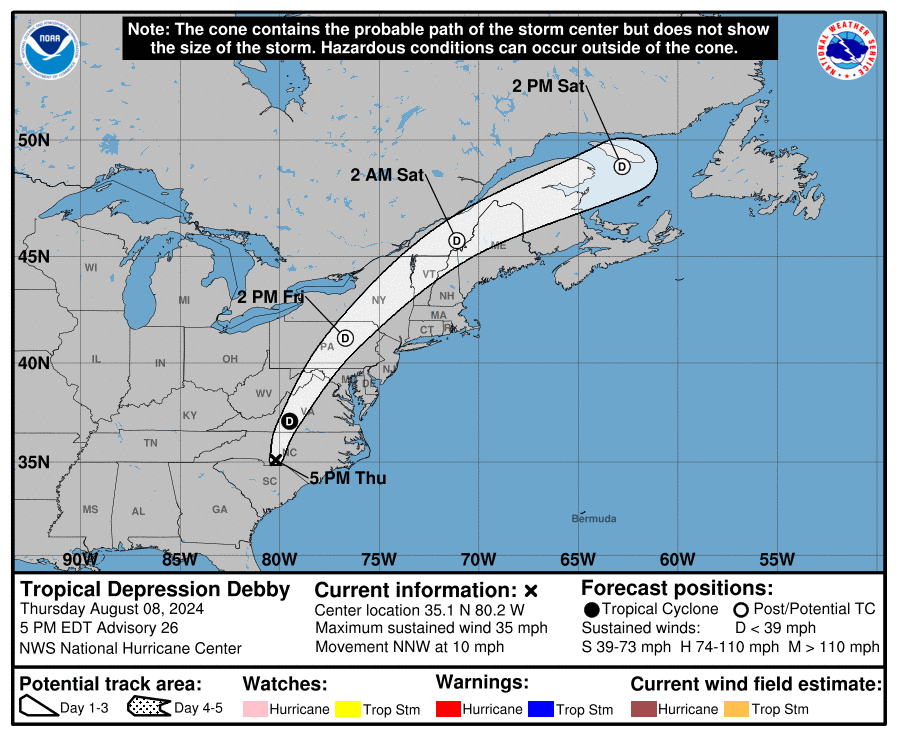
TROPICAL DEPRESSION DEBBY
TROPICAL DEPRESSION DEBBY
Coastal Watches/Warnings and Forecast Cone for Storm Center
* If the storm is forecast to dissipate within 3 days, the “Full Forecast” and “3 day” graphic will be identical
Click Here for a 5-day Cone Printer Friendly Graphic
How to use the cone graphic (video):
About this product:
This graphic shows an approximate representation of coastal areas under a hurricane warning (red), hurricane watch (pink),
tropical storm warning (blue) and tropical storm watch (yellow). The orange circle indicates the current position of the
center of the tropical cyclone. The black line, when selected, and dots show the National Hurricane Center (NHC) forecast track of the center
at the times indicated. The dot indicating the forecast center location will be black if the cyclone is forecast to be
tropical and will be white with a black outline if the cyclone is forecast to be extratropical. If only an L is displayed,
then the system is forecast to be a remnant low. The letter inside the dot indicates the NHC’s forecast intensity for that time:
D: Tropical Depression – wind speed less than 39 MPH
S: Tropical Storm – wind speed between 39 MPH and 73 MPH
H: Hurricane – wind speed between 74 MPH and 110 MPH
M: Major Hurricane – wind speed greater than 110 MPH
NHC tropical cyclone forecast tracks can be in error. This forecast
uncertainty is conveyed by the track forecast “cone”, the solid white
and stippled white areas in the graphic. The solid white area depicts
the track forecast uncertainty for days 1-3 of the forecast, while the
stippled area depicts the uncertainty on days 4-5. Historical data
indicate that the entire 5-day path of the center of the tropical
cyclone will remain within the cone about 60-70% of the time. To
form the cone, a set of imaginary circles are placed along the
forecast track at the 12, 24, 36, 48, 72, 96, and 120 h positions,
where the size of each circle is set so that it encloses 67% of the
previous five years official forecast errors. The cone is then formed
by smoothly connecting the area swept out by the set of circles.
It is also important to realize that a tropical cyclone is not a point. Their
effects can span many hundreds of miles from the center. The area
experiencing hurricane force (one-minute average wind speeds of at least
74 mph) and tropical storm force (one-minute average wind speeds of
39-73 mph) winds can extend well beyond the white areas shown enclosing
the most likely track area of the center. The distribution of hurricane
and tropical storm force winds in this tropical cyclone can be seen in
the Wind History graphic linked above.
Considering the combined forecast uncertainties in track, intensity, and size, the
chances that any particular location will experience winds of 34 kt (tropical storm force),
50 kt, or 64 kt (hurricane force) from this tropical cyclone are presented in
tabular form for selected locations and forecast positions. This information is also presented in
graphical form for the 34 kt, 50 kt,
and 64 kt thresholds.
Note: A detailed definition of the NHC track forecast cone is also available.
Originally Posted at:
NATIONAL HURRICANE CENTER and CENTRAL PACIFIC HURRICANE CENTER
At The NATIONAL OCEANIC AND ATMOSPHERIC ADMINISTRATION
Stay Updated with news.freeptomaineradio.com’s Daily Newsletter
Stay informed! Subscribe to our daily newsletter to receive updates on our latest blog posts directly in your inbox. Don’t let important information get buried by big tech.
Current subscribers:
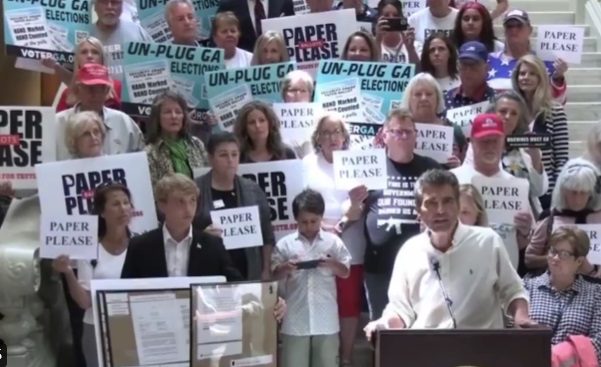
“Georgia Owes President Donald Trump an Apology” – Fulton County to Address Voter Fraud Issues in 2020 Election in Wednesday Special Hearing
by Jim Hoft, The Gateway Pundit:
“Georgia owes President Trump an Apology” says election integrity expert Joe Rossi in Fulton County.
More evidence came out recently summarizing the corruption and fraud in the 2020 Election in Georgia.
A hearing will take place this morning in Georgia to discuss the corrupt acts that occurred in Fulton County in the 2020 Election.
TRUTH LIVES on at https://sgtreport.tv/
🚨🚨IMPORTANT🚨🚨
GA State Election Board will discuss SEB2023-025 this morning
17,852 votes counted with no ballot images
20,713 original votes from tabulators out of thin air
3,930 duplicates counted and inserted via intentional human intervention.
a.k.a. FRAUD pic.twitter.com/gh1VtL9VBr
— Liz Harrington (@realLizUSA) August 7, 2024
“Georgia owes President Trump an apology”—Joe Rossi discusses the fraud uncovered in Fulton County during the 2020 Election. Instead of apologizing, the corrupt politicians in Georgia are covering up their crimes and working with the corrupt DA Fani Willis to indict President Trump for claiming that the election in the state was stolen.
Read More @ TheGatewayPundit.com
Originally Posted at https://www.sgtreport.com
Stay Updated with news.freeptomaineradio.com’s Daily Newsletter
Stay informed! Subscribe to our daily newsletter to receive updates on our latest blog posts directly in your inbox. Don’t let important information get buried by big tech.
Current subscribers:
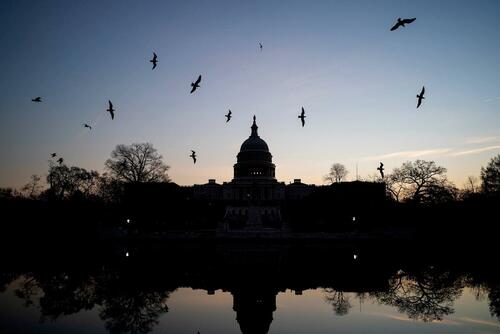
2024 Echoes ‘1984’ | ZeroHedge
Authored by Victor Joecks via American Greatness,
The book “1984” is supposed to be a warning. Today’s leftists are using it as an instruction manual…
George Orwell’s classic novel is set in a dystopian world where Big Brother controls the population through information control and surveillance. See if any of this sounds familiar.
“Doublethink means the power of holding two contradictory beliefs in one’s mind simultaneously, and accepting both of them.”
During her career, especially when running for president in 2020, Kamala Harris took a number of radical positions. She praised efforts to defund the police. She once insinuated that Immigration and Customs Enforcement was comparable to the KKK and suggested the agency should be rebuilt “from scratch.” She wanted to decriminalize border crossings. She co-sponsored the Green New Deal. She supported a mandatory gun buyback program, eliminating private insurance and reparations. She was in favor of banning fracking and plastic straws.
Those policies play great in San Francisco, but not in battleground states. Not to worry. She’s flip-flopped on at least five major policy positions since becoming the presumptive nominee.
Instead of exposing this duplicity, the national mainstream media is participating in it.
“Harris is calibrating her policy pitch for going to battle with Trump,” the Associated Press wrote about her reversals.
“If the Party could thrust its hand into the past and say of this or that event, it never happened — that, surely, was more terrifying than mere torture and death.”
The attempted assassination of Donald Trump happened just over three weeks ago. The iconic photo of a bloodied Trump defiantly standing and pumping his fist went viral. Outside of conservative sites and social media accounts, it’s barely been seen since. The national media has largely moved on, eager to fluff up Harris.
Less than two weeks ago, pro-Hamas rioters stormed Washington, D.C., to protest Israeli Prime Minister Benjamin Netanyahu speaking to Congress. They tore down U.S. flags outside of Union Station and raised Palestinian flags. They burned an American flag, vandalized monuments and assaulted park police. Charges against some of the few people arrested have already been dropped.
An easy prediction: You’ll hear less about these two stories than Trump’s out-of-context “bloodbath” remark and Jan. 6. It’s like events that would make Trump look heroic and hurt the left never happened.
“Every record has been destroyed or falsified, every book rewritten …”
You can see this happening in real time. Last week, I googled “Trump rally.” The top result was “Kamala Harris rally in Atlanta.” The same thing happened to Elon Musk and many others.
Recently, Meta AI refused to acknowledge that Trump was almost assassinated. Meta is the parent company of Facebook. It inaccurately labeled a fist-pumping photo of a bloodied Trump as “altered.” When people used Google to search for information on Trump’s attempted assassination, its auto-fill wouldn’t even suggest his name.
Both companies claim they weren’t trying to rig search results. Those excuses would be more believable if almost all mistakes like these didn’t go in the same direction.
“Don’t you see that the whole aim of Newspeak is to narrow the range of thought? In the end, we shall make thoughtcrime literally impossible, because there will be no words in which to express it.”
Illegal aliens are merely undocumented migrants. Men who claim to be women are women. People voting for Donald Trump are a threat to democracy. Ramming scissors into the skull of an 8-month-old preborn baby and sucking her brains out is health care. Israel is the oppressor for defending itself against genocidal terrorists. Diversity requires ideological conformity.
2024 looks a lot like “1984,” but you get to help write the ending. Choose wisely.
Loading…
Originally Posted at; https://www.zerohedge.com//
Stay Updated with news.freeptomaineradio.com’s Daily Newsletter
Stay informed! Subscribe to our daily newsletter to receive updates on our latest blog posts directly in your inbox. Don’t let important information get buried by big tech.
Current subscribers:

Exclusive — Trump Tells Breitbart He’ll Solve Ukraine-Russia War ‘Before I Get to the White House, After I’m President-Elect’
PALM BEACH, Florida — Former President Donald Trump told Breitbart News exclusively on Thursday evening that he intends to negotiate peace between Russia and Ukraine as President-elect before he even is sworn in as the next president of the United States.
Trump, in an hourlong interview with Breitbart News at his luxurious seaside resort and club, Mar-a-Lago, here in South Florida, said that he wants to see the war between Russia and Ukraine “settled.”
“I want to see it settled,” Trump said. “I want to get it done.”
Trump said he knows Russian president Vladimir Putin and Ukrainian president Volodymyr Zelensky, and believes he can negotiate peace to end the “death” and “destruction” if elected again on Nov. 5.
“I know both heads of the countries,” Trump said. “I know President Putin very well. I want to see the death stopping. There’s death and there’s destruction. They are destroying the whole fabric of a certain part of the world. I want to get it negotiated, and get it done.”
Republican presidential nominee former President Donald Trump speaks to reporters during a news conference at his Mar-a-Lago estate Thursday, Aug. 8, 2024, in Palm Beach, Fla. (AP Photo/Alex Brandon)
Trump said his Democrat opponent, Vice President Kamala Harris, would keep the war going and keep flowing hundreds of billions of American tax dollars into Ukraine rather than ending it. He said Harris would do nothing, and because of her inaction “millions of people will die” if she were to win the election in November. He also said Harris’s ineptitude could drag the world into a global war.
“I don’t think she has any clue,” Trump said. “She wouldn’t handle it at all. I don’t think she’d do anything. I think it would just go on and millions of people will die. It could evolve into a World War also. She’s got no capability to get it done. I want to get it done. I’ve always had a very good relationship with both men and I think I’m in a very good position. It would have been easier to get done—it would have never started. If I were there, it would have never started.”
Trump also said he hopes he will be able to negotiate the peace deal ending the war in the timeframe between the Nov. 5 election and the Jan. 20, 2025, inauguration, should he win.
“You look at the heritage of the country—the cities are mostly knocked down,” Trump said, describing Ukraine. “They’re flattened. They’re just totally flattened. Have you ever seen some of these cities? There’s not a building standing. The country has been devastated. So I want to get it solved and I will be able to get it solved. And I’d like to do it before I get to the White House after I’m president-elect.”
Much more from Trump’s latest interview with Breitbart News is coming soon.
Originally Posted At www.breitbart.com
Stay Updated with news.freeptomaineradio.com’s Daily Newsletter
Stay informed! Subscribe to our daily newsletter to receive updates on our latest blog posts directly in your inbox. Don’t let important information get buried by big tech.
Current subscribers:
Post-Tropical Cyclone Emilia Forecast Discussion
344 WTPZ45 KNHC 090244 TCDEP5 Post-Tropical Cyclone Emilia Discussion Number 19 NWS National Hurricane Center Miami FL EP052024 800 PM PDT Thu Aug 08 2024 Emilia has failed to produce much in the way of organized convection since the prior burst waned earlier this morning, aside from a small patch of -50 C cloud tops currently south of the estimated center. SAB Dvorak classifications have been too weak to classify since this afternoon, while the TAFB Final-T number is down to 2.0/30-kt which was constrained from going lower. While there might continue to be some occasional puffs of convection with Emilia over the next day or so, the cyclone has crossed the 24 C isotherm and heading towards even cooler ocean waters, and the chance of a more significant convective resurgence is low. Thus, Emilia is being declared a 30-kt post-tropical remnant low this cycle, and this will be the last NHC advisory. The system continues to move generally west-northwestward at 290/10 kt. This motion should continue for the next several days followed by a turn more westward beyond 36 h as the low continues to weaken and becomes more steered by the low-level trade wind flow. The NHC track forecast is largely an update of the previous forecast, in good agreement with the multi-model consensus aids. The latest forecast now shows the remnant low dissipating after 72 h, a bit faster than before. FORECAST POSITIONS AND MAX WINDS INIT 09/0300Z 22.3N 125.3W 30 KT 35 MPH...POST-TROP/REMNT LOW 12H 09/1200Z 22.9N 127.0W 30 KT 35 MPH...POST-TROP/REMNT LOW 24H 10/0000Z 23.5N 129.0W 25 KT 30 MPH...POST-TROP/REMNT LOW 36H 10/1200Z 24.1N 131.0W 25 KT 30 MPH...POST-TROP/REMNT LOW 48H 11/0000Z 24.6N 132.7W 20 KT 25 MPH...POST-TROP/REMNT LOW 60H 11/1200Z 24.8N 134.5W 20 KT 25 MPH...POST-TROP/REMNT LOW 72H 12/0000Z 24.7N 136.6W 20 KT 25 MPH...POST-TROP/REMNT LOW 96H 13/0000Z...DISSIPATED $$ Forecaster Papin
Originally Posted at:
NATIONAL HURRICANE CENTER and CENTRAL PACIFIC HURRICANE CENTER At The NATIONAL OCEANIC AND ATMOSPHERIC ADMINISTRATION
Stay Updated with news.freeptomaineradio.com’s Daily Newsletter
Stay informed! Subscribe to our daily newsletter to receive updates on our latest blog posts directly in your inbox. Don’t let important information get buried by big tech.
Current subscribers:
Post-Tropical Cyclone Emilia Wind Speed Probabilities
000
FOPZ15 KNHC 090242
PWSEP5
POST-TROPICAL CYCLONE EMILIA WIND SPEED PROBABILITIES NUMBER 19
NWS NATIONAL HURRICANE CENTER MIAMI FL EP052024
0300 UTC FRI AUG 09 2024
AT 0300Z THE CENTER OF POST-TROPICAL CYCLONE EMILIA WAS LOCATED NEAR
LATITUDE 22.3 NORTH...LONGITUDE 125.3 WEST WITH MAXIMUM SUSTAINED
WINDS NEAR 30 KTS...35 MPH...55 KM/H.
Z INDICATES COORDINATED UNIVERSAL TIME (GREENWICH)
PACIFIC DAYLIGHT TIME (PDT)...SUBTRACT 7 HOURS FROM Z TIME
HAWAIIAN STANDARD TIME (HST)...SUBTRACT 10 HOURS FROM Z TIME
WIND SPEED PROBABILITY TABLE FOR SPECIFIC LOCATIONS
CHANCES OF SUSTAINED (1-MINUTE AVERAGE) WIND SPEEDS OF AT LEAST
...34 KT (39 MPH... 63 KM/H)...
...50 KT (58 MPH... 93 KM/H)...
...64 KT (74 MPH...119 KM/H)...
FOR LOCATIONS AND TIME PERIODS DURING THE NEXT 5 DAYS
PROBABILITIES FOR LOCATIONS ARE GIVEN AS OP(CP) WHERE
OP IS THE PROBABILITY OF THE EVENT BEGINNING DURING
AN INDIVIDUAL TIME PERIOD (ONSET PROBABILITY)
(CP) IS THE PROBABILITY OF THE EVENT OCCURRING BETWEEN
00Z FRI AND THE FORECAST HOUR (CUMULATIVE PROBABILITY)
PROBABILITIES ARE GIVEN IN PERCENT
X INDICATES PROBABILITIES LESS THAN 1 PERCENT
PROBABILITIES FOR 34 KT AND 50 KT ARE SHOWN AT A GIVEN LOCATION WHEN
THE 5-DAY CUMULATIVE PROBABILITY IS AT LEAST 3 PERCENT.
PROBABILITIES FOR 34...50...64 KT SHOWN WHEN THE 5-DAY
64-KT CUMULATIVE PROBABILITY IS AT LEAST 1 PERCENT.
- - - - WIND SPEED PROBABILITIES FOR SELECTED LOCATIONS - - - -
FROM FROM FROM FROM FROM FROM FROM
TIME 00Z FRI 12Z FRI 00Z SAT 12Z SAT 00Z SUN 00Z MON 00Z TUE
PERIODS TO TO TO TO TO TO TO
12Z FRI 00Z SAT 12Z SAT 00Z SUN 00Z MON 00Z TUE 00Z WED
FORECAST HOUR (12) (24) (36) (48) (72) (96) (120)
- - - - - - - - - - - - - - - - - - - - - - - - - - - - - - - - - -
LOCATION KT
25N 130W 34 X 2( 2) 3( 5) X( 5) X( 5) X( 5) X( 5)
25N 135W 34 X X( X) X( X) 1( 1) 5( 6) X( 6) X( 6)
$$
FORECASTER PAPIN
Originally Posted at:
NATIONAL HURRICANE CENTER and CENTRAL PACIFIC HURRICANE CENTER At The NATIONAL OCEANIC AND ATMOSPHERIC ADMINISTRATION
Stay Updated with news.freeptomaineradio.com’s Daily Newsletter
Stay informed! Subscribe to our daily newsletter to receive updates on our latest blog posts directly in your inbox. Don’t let important information get buried by big tech.
Current subscribers:


